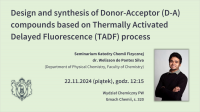Seminarium Katedry Chemii Fizycznej – dr. Welisson de Pontes Silva, Department of Physical Chemistry, Faculty of Chemistry WUT
Zapraszamy na wykład, który wygłosi dr. Welisson de Pontes Silva – Department of Physical Chemistry, Faculty of Chemistry, WUT, pt.
Design and synthesis of Donor-Acceptor (D-A) compounds based on Thermally Activated Delayed Fluorescence (TADF) process
Termin
22.11.2024 r. (piątek), godz. 12:15
Miejsce
Gmach Chemii, s. 320
Streszczenie seminarium:
Developing new organic materials for optoelectronic applications such as organic light-emitting diodes (OLEDs) continues to be a challenge due to the market demand for more efficient devices that operate with minimum energy consumption. Designing purely organic molecules exhibiting Thermally Activated Delayed Fluorescence (TADF) properties may be an excellent strategy for obtaining efficient OLED devices.
The design of TADF emitters covers mainly the combinations of electron-acceptor (A) and electron-donor (D) units in twisted D-A structures, obtaining spatially separated HOMO and LUMO orbitals and small singlet-triplet energy gap, which can allow efficient reverse intersystem crossing process (RISC).
This Seminar will try to bring the key parameters in how to design purely organic molecules to obtain TADF behavior, in how to characterize these materials and examples of synthesized compounds based on different acceptors such as quinoxalines, pyrazines, benzimidazoles and benzotriazoles in different D-A arrangements with commonly donors moieties.
Sylwetka Prelegenta:
Welisson de Pontes Silva graduated in Chemistry at the Federal University of Paraíba (UFPB) in Brazil from 2012-2016. In his Master's studies, during the period of 2016-2018, also at the Federal University of Paraíba, he worked with organic synthesis with emphasis on the design of non-conventional discotic liquid crystals presenting photoisomerization properties. He recently finished his PhD (May 2024) at the Silesian University of Technology (SUT), where he worked with organic synthesis, mainly in the design of new D-A compounds, with emphasis on Buchwald-Hartwig (N-C coupling) reactions. Aiming optoelectronic applications based on Thermally Activated Delayed Fluorescence (TADF) process. He also worked with photophysical and electrochemical characterizations of D-A compounds and applications in organic light-emitting diodes (OLEDs). Currently, he is a postdoc at the Department of Physical Chemistry in Professor Sergiusz Luliński's group.








